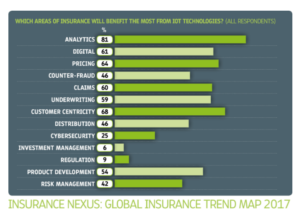08.26.20
Technology Transforming the Insurance Industry—Helping Hoosiers Prepare for the Shift
Jessica Carender, Partner Engagement Manager, The NIIC

The NIIC Connected Health Lab hosted a webinar to educate industry leaders about insurtech—otherwise known as the intersection of insurance and technology. This is rapidly changing the creation, distribution, and administration of the insurance business.
The webinar highlighted a broad range of technologies, such as Big Data, Artificial Intelligence and the Internet of Things (IoT), as well as cybersecurity, cryptocurrencies, virtual reality, drone technologies, and more. According to webinar expert panelists Greg Perigo, Director of Strategic Partnerships, Indiana Tech, and Brian O’Hara, Strategic Engagement Advisor to the FBI and a member of the Indiana Tech faculty, these technologies signal a dramatic shift in the way the insurance industry operates.
That shift will focus, in part, on how the industry collects and analyzes customer data. The goal is to provide better and more accessible service. For a traditionally analog industry, the business model change will be dramatic.
Consider these projections. According to Perigo, “By 2040, the auto insurance market will shrink 60 percent. By 2050, the number of people over 100 will grow 1,000 percent, and 80 percent of consumers will purchase usage-based coverage.” In addition, Perigo predicted, insurance claims will be handled in seconds, not days or weeks, and AI will replace underwriters. “Smart” technologies and ingestible sensors will become the medical standard for insulin delivery, bronchial inhalers, and more.
In some ways, this technology is a present reality. For example, the trucking industry is already testing “smart socks” for drivers. These socks record how much rest a driver is getting, along with the driver’s blood sugar levels and oxygen intake.
“The healthcare industry is also using technology to monitor pain management and cancer treatments,” said O’Hara, “with smart beds recording patient stats and helping the medical team make more informed decisions for patient care.”
Through technologies like these, insurtech provides companies with the opportunity to collect data that will give better service and better rates to clients and customers. Some of the benefits of insurtech for consumers include more responsive claims handling, streamlined policy issuance and reduced physical underwriting risk.
Of course, these benefits also present certain risks, primarily in the realm of client privacy. “We’re going to think very closely about privacy,” said O’Hara. “If you’ve been in a car accident in a recently constructed vehicle, you know that insurance companies can extract data about traffic and road conditions from that little computer and all those sensors in your car. This will speed up claims, but it will also give insurers all this data about how fast you were driving and how you braked, for instance.”
O’Hara also recommended that users lobby for privacy and “read those agreements you’re asked to sign. Make sure you have control over your data and choose who has access to it and where you share it. Talk to your legislators. I strongly believe that GDPR standards like they use in Europe are heading to the US.”
These security issues are just one of the topics covered in a new undergraduate insurtech program through Indiana Tech’s College of Business. “The insurtech concentration consists of nine courses designed to equip people in the insurance and entrepreneurial fields with the skills they need to launch careers in this rapidly changing landscape,” said Perigo. Courses cover risk management and emerging technologies, as well as cyber risk and liability, and more.
The live-streamed discussion of insurtech aligned well with the Connected Health Lab’s mission to connect entrepreneurs, business builders, and interested groups with innovative IoT ideas, resources, tools, and networks.
The NIIC’s Connected Health Lab was created to foster an entrepreneurial ecosystem for developing healthcare IoT ideas into innovative products, new or expanded businesses, and new markets. For more information about future Connected Health Lab events, visit www.niic.net/iot.

